Leadership Styles: Theories, Advantages, and Disadvantages
VerifiedAdded on 2020/10/22
|19
|3819
|270
Report
AI Summary
This report provides a comprehensive overview of various leadership styles, including transactional, transformational, autocratic, democratic, and laissez-faire leadership. It delves into the core principles, advantages, and disadvantages of each style, offering insights into their application in business operations and their impact on employee motivation and organizational performance. The report also includes a reflection on the individual's experience with the research, providing a well-rounded understanding of the topic. It examines how each style influences decision-making, team dynamics, and the overall achievement of organizational goals. The analysis covers the strengths and weaknesses of each approach, helping readers understand the best fit for different organizational contexts. This assignment is available on Desklib, a platform offering students access to AI-powered study tools and resources.
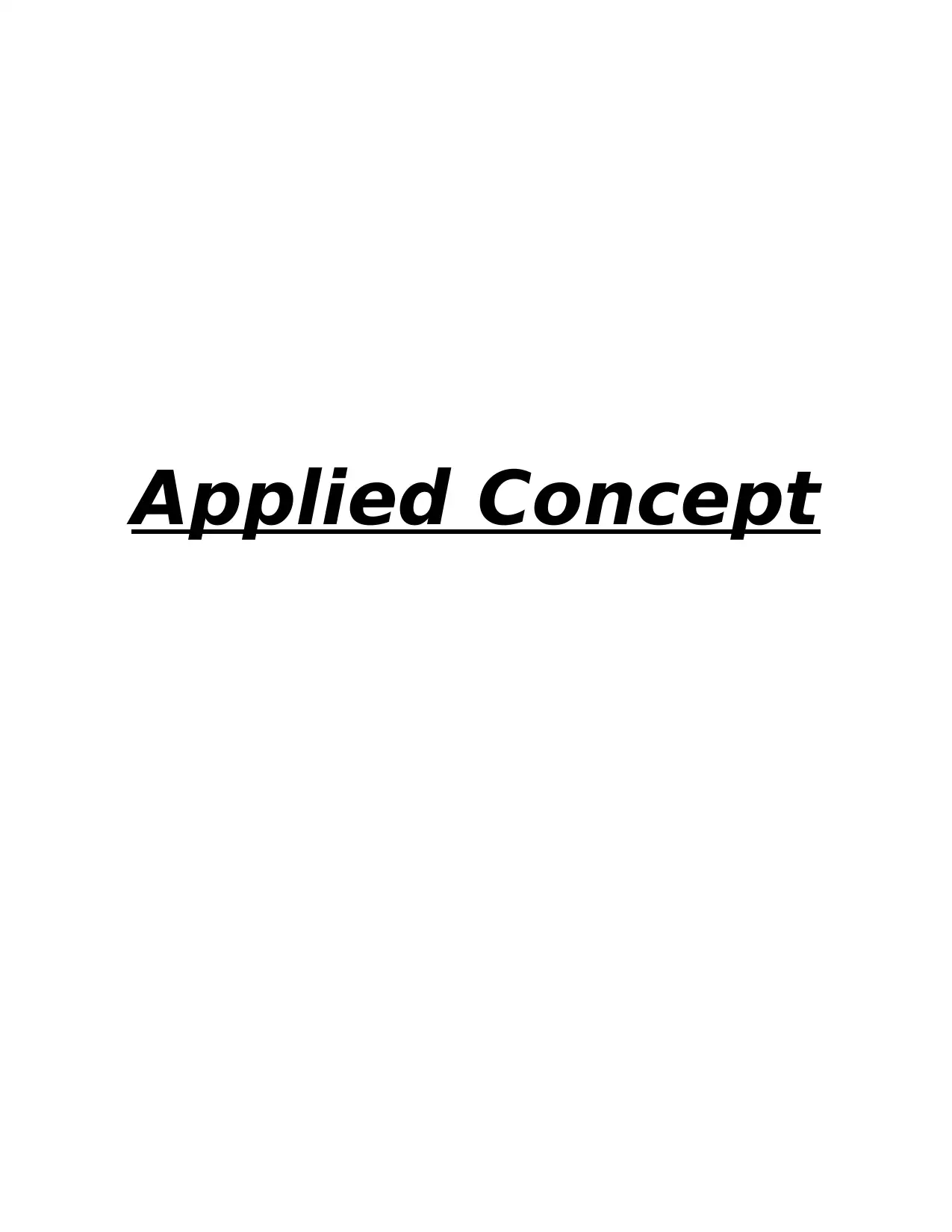
Applied Concept
Paraphrase This Document
Need a fresh take? Get an instant paraphrase of this document with our AI Paraphraser
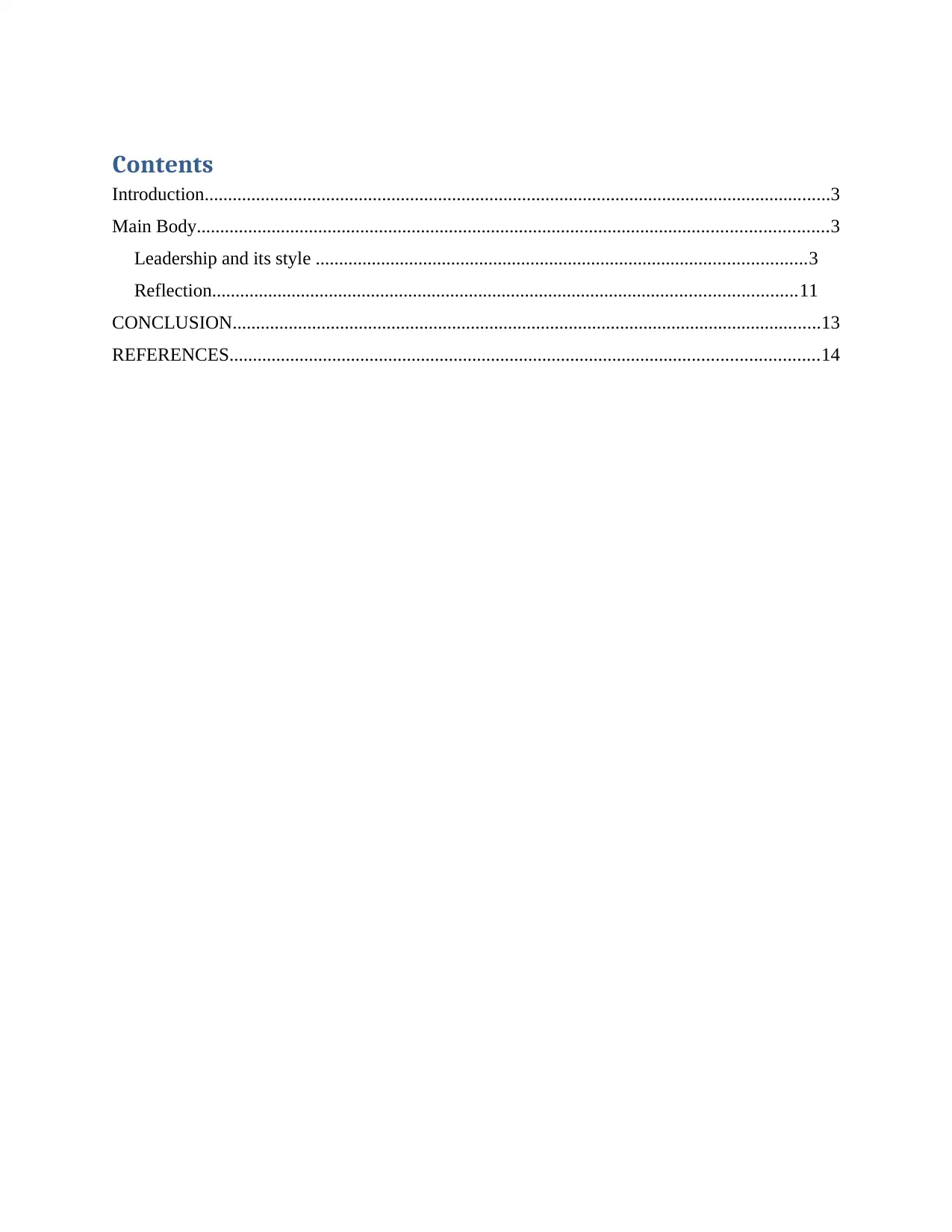
Contents
Introduction......................................................................................................................................3
Main Body.......................................................................................................................................3
Leadership and its style .........................................................................................................3
Reflection.............................................................................................................................11
CONCLUSION..............................................................................................................................13
REFERENCES..............................................................................................................................14
Introduction......................................................................................................................................3
Main Body.......................................................................................................................................3
Leadership and its style .........................................................................................................3
Reflection.............................................................................................................................11
CONCLUSION..............................................................................................................................13
REFERENCES..............................................................................................................................14
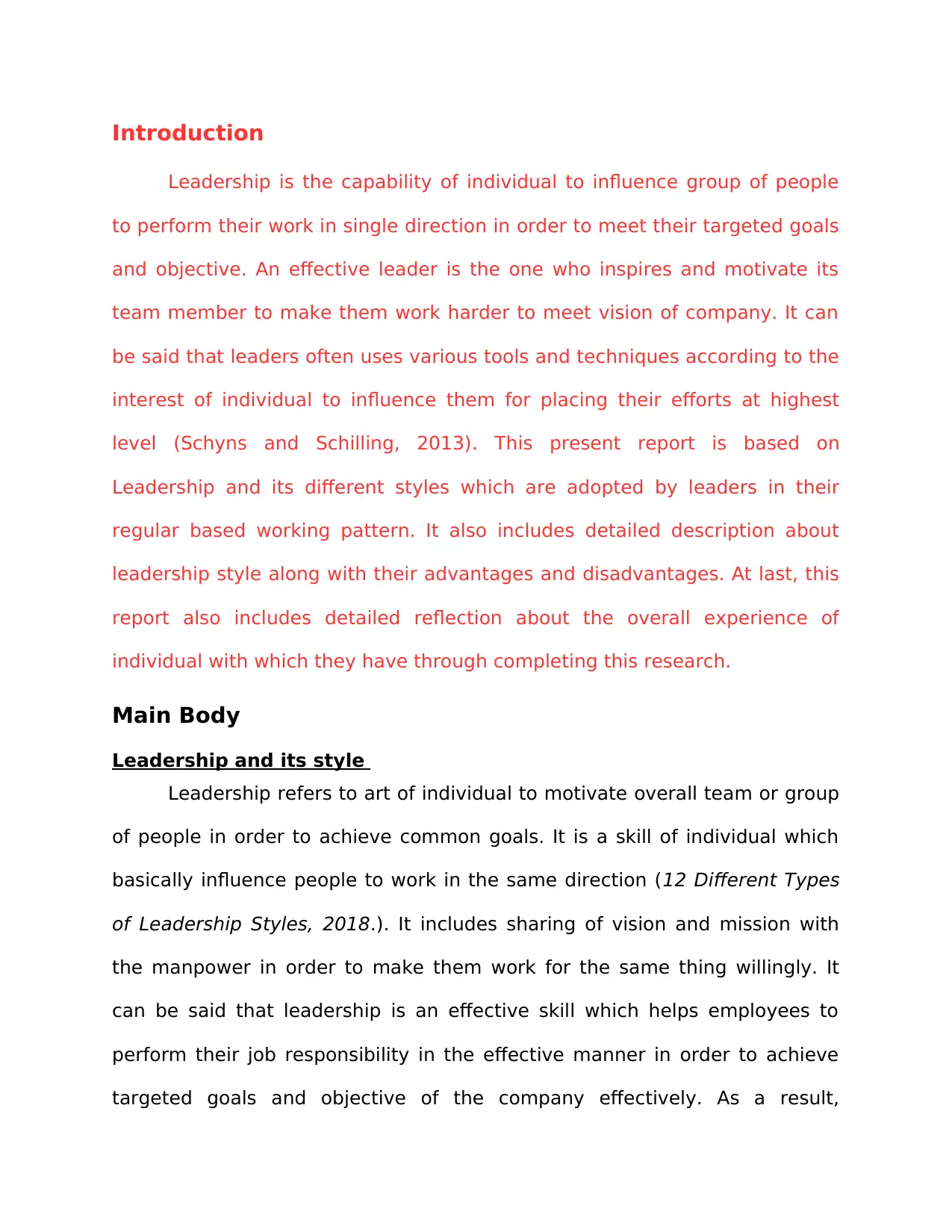
Introduction
Leadership is the capability of individual to influence group of people
to perform their work in single direction in order to meet their targeted goals
and objective. An effective leader is the one who inspires and motivate its
team member to make them work harder to meet vision of company. It can
be said that leaders often uses various tools and techniques according to the
interest of individual to influence them for placing their efforts at highest
level (Schyns and Schilling, 2013). This present report is based on
Leadership and its different styles which are adopted by leaders in their
regular based working pattern. It also includes detailed description about
leadership style along with their advantages and disadvantages. At last, this
report also includes detailed reflection about the overall experience of
individual with which they have through completing this research.
Main Body
Leadership and its style
Leadership refers to art of individual to motivate overall team or group
of people in order to achieve common goals. It is a skill of individual which
basically influence people to work in the same direction (12 Different Types
of Leadership Styles, 2018.). It includes sharing of vision and mission with
the manpower in order to make them work for the same thing willingly. It
can be said that leadership is an effective skill which helps employees to
perform their job responsibility in the effective manner in order to achieve
targeted goals and objective of the company effectively. As a result,
Leadership is the capability of individual to influence group of people
to perform their work in single direction in order to meet their targeted goals
and objective. An effective leader is the one who inspires and motivate its
team member to make them work harder to meet vision of company. It can
be said that leaders often uses various tools and techniques according to the
interest of individual to influence them for placing their efforts at highest
level (Schyns and Schilling, 2013). This present report is based on
Leadership and its different styles which are adopted by leaders in their
regular based working pattern. It also includes detailed description about
leadership style along with their advantages and disadvantages. At last, this
report also includes detailed reflection about the overall experience of
individual with which they have through completing this research.
Main Body
Leadership and its style
Leadership refers to art of individual to motivate overall team or group
of people in order to achieve common goals. It is a skill of individual which
basically influence people to work in the same direction (12 Different Types
of Leadership Styles, 2018.). It includes sharing of vision and mission with
the manpower in order to make them work for the same thing willingly. It
can be said that leadership is an effective skill which helps employees to
perform their job responsibility in the effective manner in order to achieve
targeted goals and objective of the company effectively. As a result,
⊘ This is a preview!⊘
Do you want full access?
Subscribe today to unlock all pages.

Trusted by 1+ million students worldwide
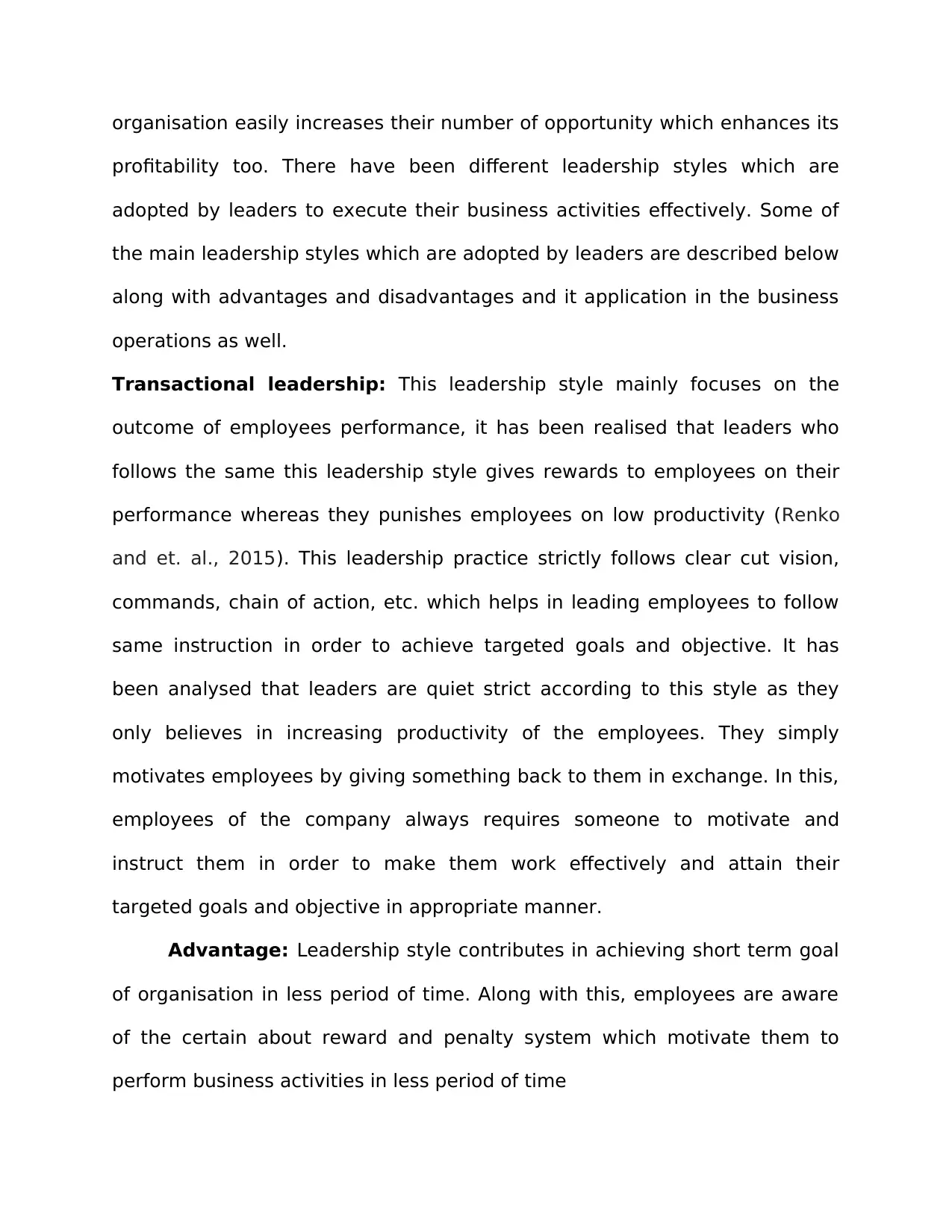
organisation easily increases their number of opportunity which enhances its
profitability too. There have been different leadership styles which are
adopted by leaders to execute their business activities effectively. Some of
the main leadership styles which are adopted by leaders are described below
along with advantages and disadvantages and it application in the business
operations as well.
Transactional leadership: This leadership style mainly focuses on the
outcome of employees performance, it has been realised that leaders who
follows the same this leadership style gives rewards to employees on their
performance whereas they punishes employees on low productivity (Renko
and et. al., 2015). This leadership practice strictly follows clear cut vision,
commands, chain of action, etc. which helps in leading employees to follow
same instruction in order to achieve targeted goals and objective. It has
been analysed that leaders are quiet strict according to this style as they
only believes in increasing productivity of the employees. They simply
motivates employees by giving something back to them in exchange. In this,
employees of the company always requires someone to motivate and
instruct them in order to make them work effectively and attain their
targeted goals and objective in appropriate manner.
Advantage: Leadership style contributes in achieving short term goal
of organisation in less period of time. Along with this, employees are aware
of the certain about reward and penalty system which motivate them to
perform business activities in less period of time
profitability too. There have been different leadership styles which are
adopted by leaders to execute their business activities effectively. Some of
the main leadership styles which are adopted by leaders are described below
along with advantages and disadvantages and it application in the business
operations as well.
Transactional leadership: This leadership style mainly focuses on the
outcome of employees performance, it has been realised that leaders who
follows the same this leadership style gives rewards to employees on their
performance whereas they punishes employees on low productivity (Renko
and et. al., 2015). This leadership practice strictly follows clear cut vision,
commands, chain of action, etc. which helps in leading employees to follow
same instruction in order to achieve targeted goals and objective. It has
been analysed that leaders are quiet strict according to this style as they
only believes in increasing productivity of the employees. They simply
motivates employees by giving something back to them in exchange. In this,
employees of the company always requires someone to motivate and
instruct them in order to make them work effectively and attain their
targeted goals and objective in appropriate manner.
Advantage: Leadership style contributes in achieving short term goal
of organisation in less period of time. Along with this, employees are aware
of the certain about reward and penalty system which motivate them to
perform business activities in less period of time
Paraphrase This Document
Need a fresh take? Get an instant paraphrase of this document with our AI Paraphraser
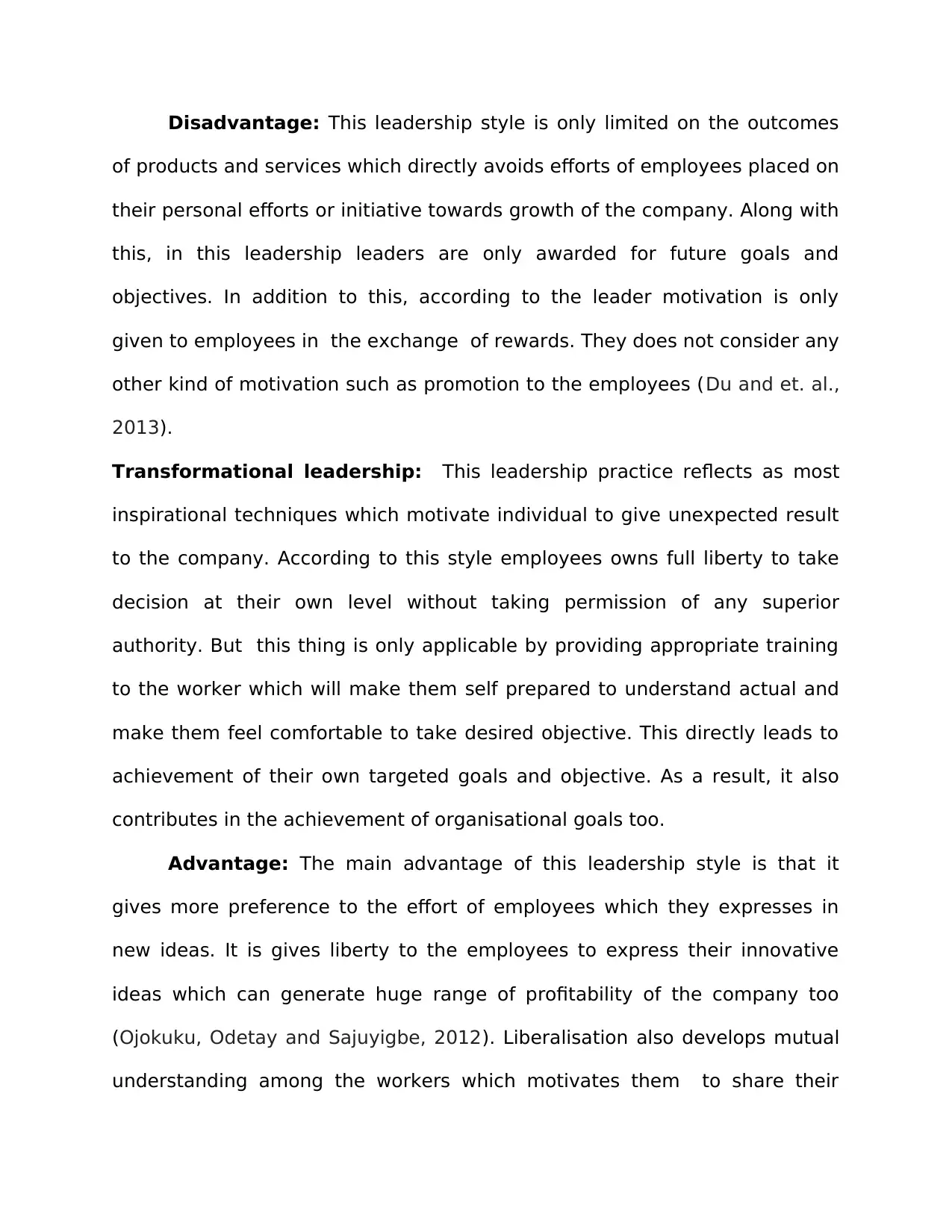
Disadvantage: This leadership style is only limited on the outcomes
of products and services which directly avoids efforts of employees placed on
their personal efforts or initiative towards growth of the company. Along with
this, in this leadership leaders are only awarded for future goals and
objectives. In addition to this, according to the leader motivation is only
given to employees in the exchange of rewards. They does not consider any
other kind of motivation such as promotion to the employees (Du and et. al.,
2013).
Transformational leadership: This leadership practice reflects as most
inspirational techniques which motivate individual to give unexpected result
to the company. According to this style employees owns full liberty to take
decision at their own level without taking permission of any superior
authority. But this thing is only applicable by providing appropriate training
to the worker which will make them self prepared to understand actual and
make them feel comfortable to take desired objective. This directly leads to
achievement of their own targeted goals and objective. As a result, it also
contributes in the achievement of organisational goals too.
Advantage: The main advantage of this leadership style is that it
gives more preference to the effort of employees which they expresses in
new ideas. It is gives liberty to the employees to express their innovative
ideas which can generate huge range of profitability of the company too
(Ojokuku, Odetay and Sajuyigbe, 2012). Liberalisation also develops mutual
understanding among the workers which motivates them to share their
of products and services which directly avoids efforts of employees placed on
their personal efforts or initiative towards growth of the company. Along with
this, in this leadership leaders are only awarded for future goals and
objectives. In addition to this, according to the leader motivation is only
given to employees in the exchange of rewards. They does not consider any
other kind of motivation such as promotion to the employees (Du and et. al.,
2013).
Transformational leadership: This leadership practice reflects as most
inspirational techniques which motivate individual to give unexpected result
to the company. According to this style employees owns full liberty to take
decision at their own level without taking permission of any superior
authority. But this thing is only applicable by providing appropriate training
to the worker which will make them self prepared to understand actual and
make them feel comfortable to take desired objective. This directly leads to
achievement of their own targeted goals and objective. As a result, it also
contributes in the achievement of organisational goals too.
Advantage: The main advantage of this leadership style is that it
gives more preference to the effort of employees which they expresses in
new ideas. It is gives liberty to the employees to express their innovative
ideas which can generate huge range of profitability of the company too
(Ojokuku, Odetay and Sajuyigbe, 2012). Liberalisation also develops mutual
understanding among the workers which motivates them to share their
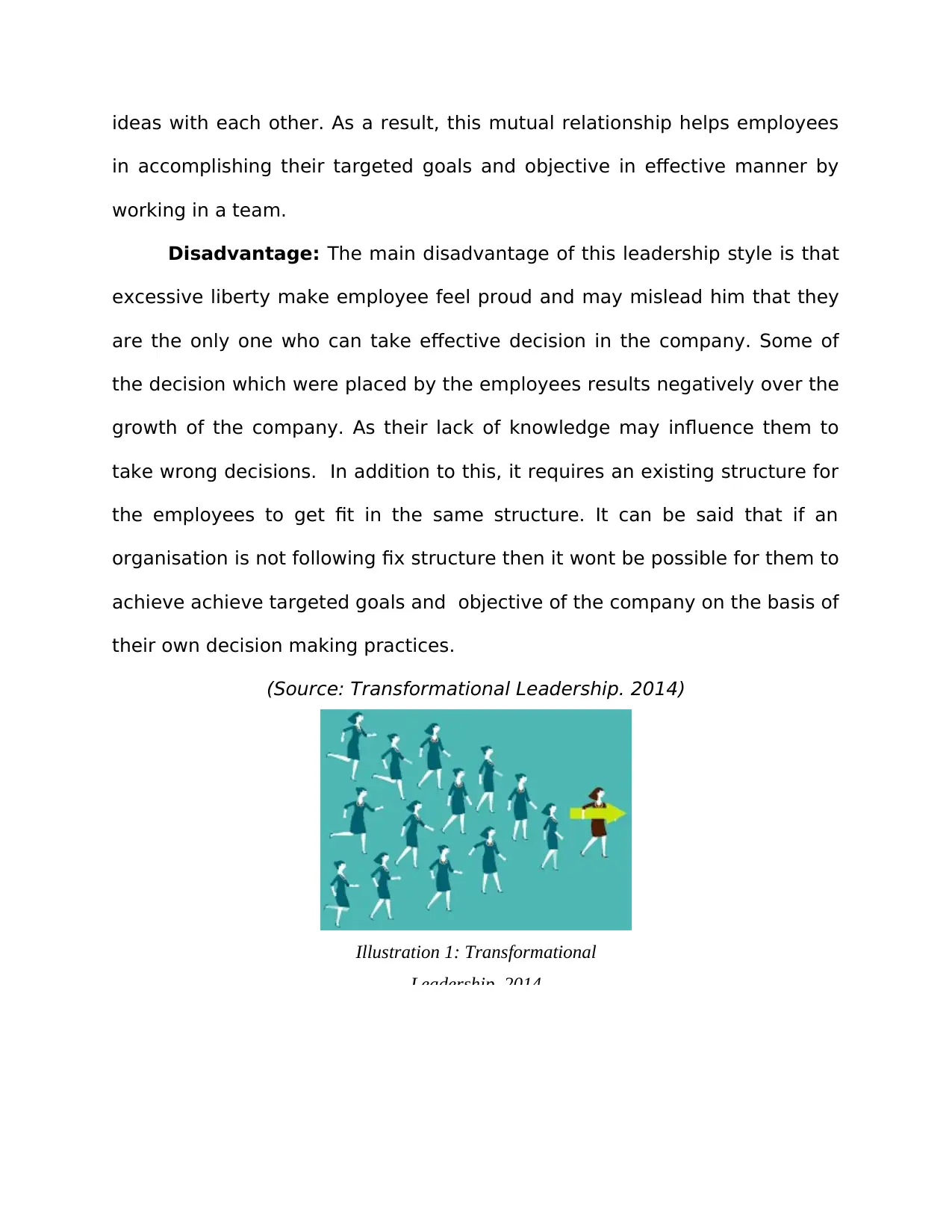
ideas with each other. As a result, this mutual relationship helps employees
in accomplishing their targeted goals and objective in effective manner by
working in a team.
Disadvantage: The main disadvantage of this leadership style is that
excessive liberty make employee feel proud and may mislead him that they
are the only one who can take effective decision in the company. Some of
the decision which were placed by the employees results negatively over the
growth of the company. As their lack of knowledge may influence them to
take wrong decisions. In addition to this, it requires an existing structure for
the employees to get fit in the same structure. It can be said that if an
organisation is not following fix structure then it wont be possible for them to
achieve achieve targeted goals and objective of the company on the basis of
their own decision making practices.
(Source: Transformational Leadership. 2014)
Illustration 1: Transformational
Leadership. 2014
in accomplishing their targeted goals and objective in effective manner by
working in a team.
Disadvantage: The main disadvantage of this leadership style is that
excessive liberty make employee feel proud and may mislead him that they
are the only one who can take effective decision in the company. Some of
the decision which were placed by the employees results negatively over the
growth of the company. As their lack of knowledge may influence them to
take wrong decisions. In addition to this, it requires an existing structure for
the employees to get fit in the same structure. It can be said that if an
organisation is not following fix structure then it wont be possible for them to
achieve achieve targeted goals and objective of the company on the basis of
their own decision making practices.
(Source: Transformational Leadership. 2014)
Illustration 1: Transformational
Leadership. 2014
⊘ This is a preview!⊘
Do you want full access?
Subscribe today to unlock all pages.

Trusted by 1+ million students worldwide
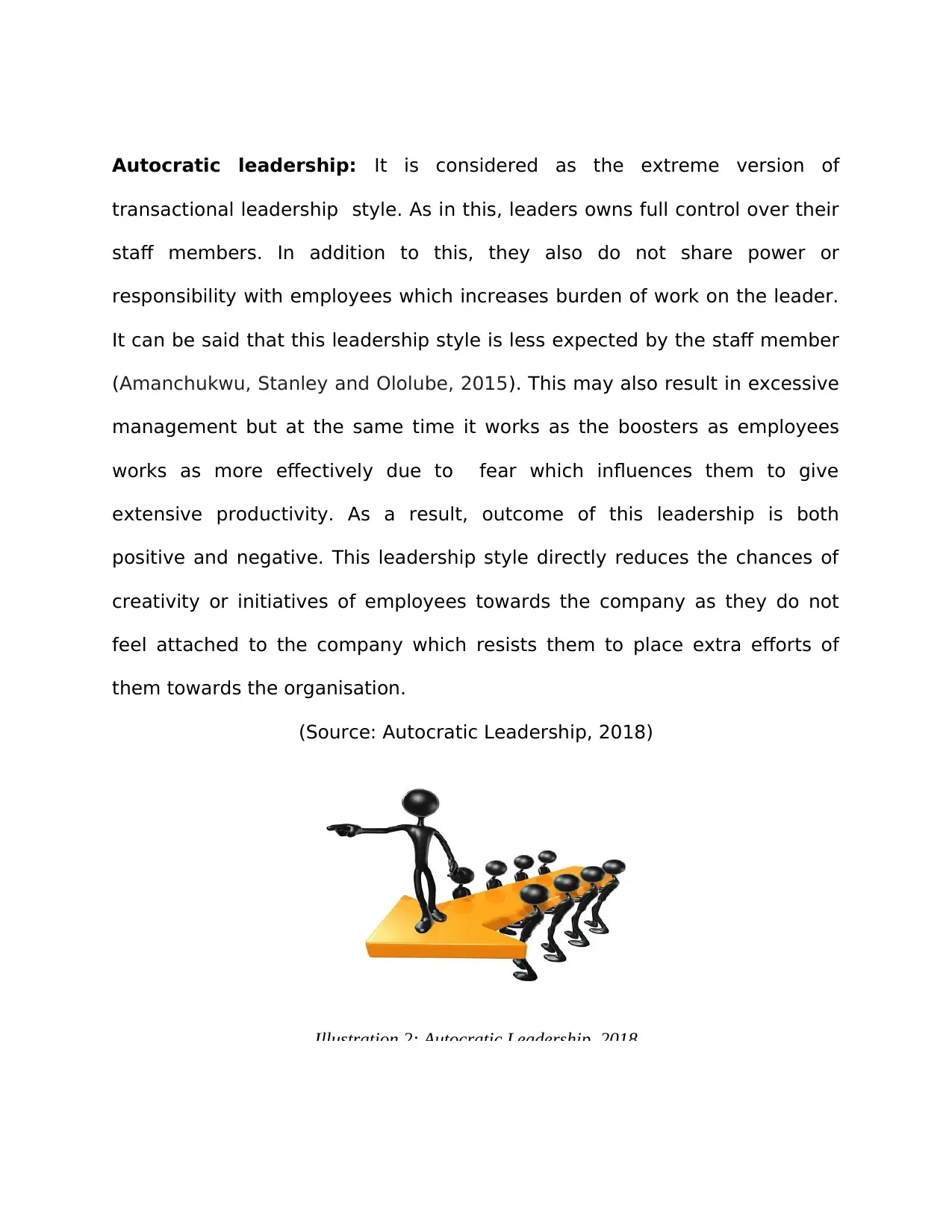
Autocratic leadership: It is considered as the extreme version of
transactional leadership style. As in this, leaders owns full control over their
staff members. In addition to this, they also do not share power or
responsibility with employees which increases burden of work on the leader.
It can be said that this leadership style is less expected by the staff member
(Amanchukwu, Stanley and Ololube, 2015). This may also result in excessive
management but at the same time it works as the boosters as employees
works as more effectively due to fear which influences them to give
extensive productivity. As a result, outcome of this leadership is both
positive and negative. This leadership style directly reduces the chances of
creativity or initiatives of employees towards the company as they do not
feel attached to the company which resists them to place extra efforts of
them towards the organisation.
(Source: Autocratic Leadership, 2018)
Illustration 2: Autocratic Leadership. 2018
transactional leadership style. As in this, leaders owns full control over their
staff members. In addition to this, they also do not share power or
responsibility with employees which increases burden of work on the leader.
It can be said that this leadership style is less expected by the staff member
(Amanchukwu, Stanley and Ololube, 2015). This may also result in excessive
management but at the same time it works as the boosters as employees
works as more effectively due to fear which influences them to give
extensive productivity. As a result, outcome of this leadership is both
positive and negative. This leadership style directly reduces the chances of
creativity or initiatives of employees towards the company as they do not
feel attached to the company which resists them to place extra efforts of
them towards the organisation.
(Source: Autocratic Leadership, 2018)
Illustration 2: Autocratic Leadership. 2018
Paraphrase This Document
Need a fresh take? Get an instant paraphrase of this document with our AI Paraphraser
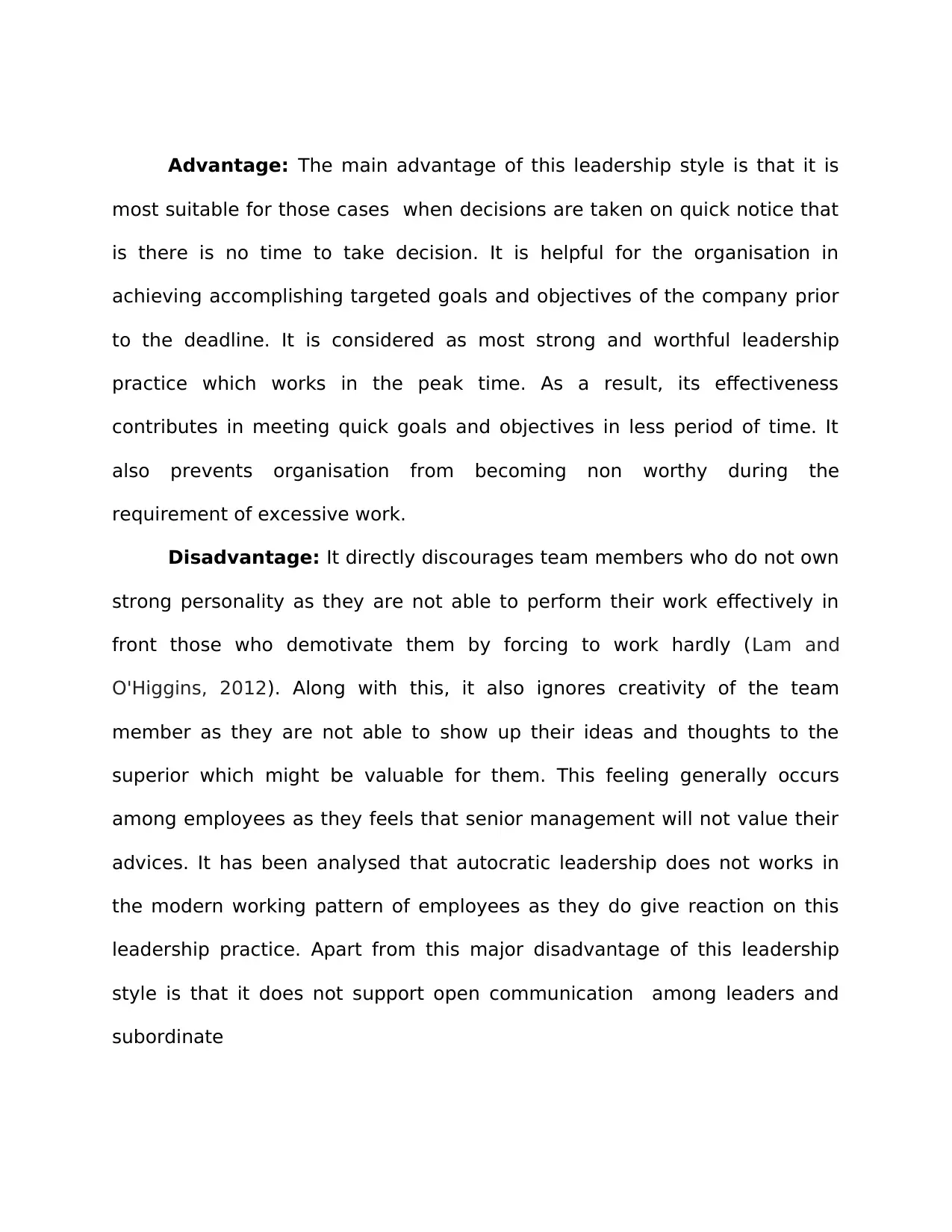
Advantage: The main advantage of this leadership style is that it is
most suitable for those cases when decisions are taken on quick notice that
is there is no time to take decision. It is helpful for the organisation in
achieving accomplishing targeted goals and objectives of the company prior
to the deadline. It is considered as most strong and worthful leadership
practice which works in the peak time. As a result, its effectiveness
contributes in meeting quick goals and objectives in less period of time. It
also prevents organisation from becoming non worthy during the
requirement of excessive work.
Disadvantage: It directly discourages team members who do not own
strong personality as they are not able to perform their work effectively in
front those who demotivate them by forcing to work hardly (Lam and
O'Higgins, 2012). Along with this, it also ignores creativity of the team
member as they are not able to show up their ideas and thoughts to the
superior which might be valuable for them. This feeling generally occurs
among employees as they feels that senior management will not value their
advices. It has been analysed that autocratic leadership does not works in
the modern working pattern of employees as they do give reaction on this
leadership practice. Apart from this major disadvantage of this leadership
style is that it does not support open communication among leaders and
subordinate
most suitable for those cases when decisions are taken on quick notice that
is there is no time to take decision. It is helpful for the organisation in
achieving accomplishing targeted goals and objectives of the company prior
to the deadline. It is considered as most strong and worthful leadership
practice which works in the peak time. As a result, its effectiveness
contributes in meeting quick goals and objectives in less period of time. It
also prevents organisation from becoming non worthy during the
requirement of excessive work.
Disadvantage: It directly discourages team members who do not own
strong personality as they are not able to perform their work effectively in
front those who demotivate them by forcing to work hardly (Lam and
O'Higgins, 2012). Along with this, it also ignores creativity of the team
member as they are not able to show up their ideas and thoughts to the
superior which might be valuable for them. This feeling generally occurs
among employees as they feels that senior management will not value their
advices. It has been analysed that autocratic leadership does not works in
the modern working pattern of employees as they do give reaction on this
leadership practice. Apart from this major disadvantage of this leadership
style is that it does not support open communication among leaders and
subordinate
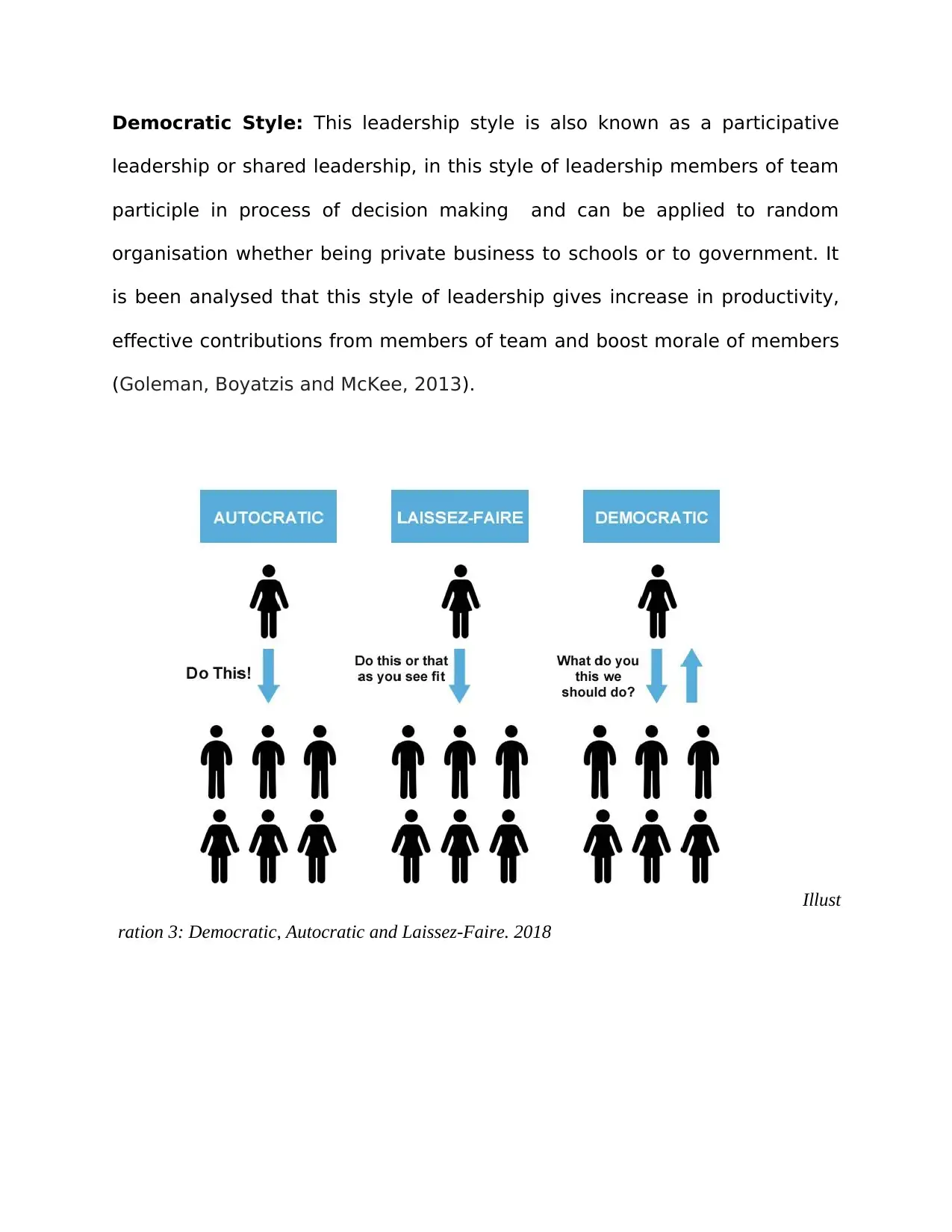
Democratic Style: This leadership style is also known as a participative
leadership or shared leadership, in this style of leadership members of team
participle in process of decision making and can be applied to random
organisation whether being private business to schools or to government. It
is been analysed that this style of leadership gives increase in productivity,
effective contributions from members of team and boost morale of members
(Goleman, Boyatzis and McKee, 2013).
Illust
ration 3: Democratic, Autocratic and Laissez-Faire. 2018
leadership or shared leadership, in this style of leadership members of team
participle in process of decision making and can be applied to random
organisation whether being private business to schools or to government. It
is been analysed that this style of leadership gives increase in productivity,
effective contributions from members of team and boost morale of members
(Goleman, Boyatzis and McKee, 2013).
Illust
ration 3: Democratic, Autocratic and Laissez-Faire. 2018
⊘ This is a preview!⊘
Do you want full access?
Subscribe today to unlock all pages.

Trusted by 1+ million students worldwide
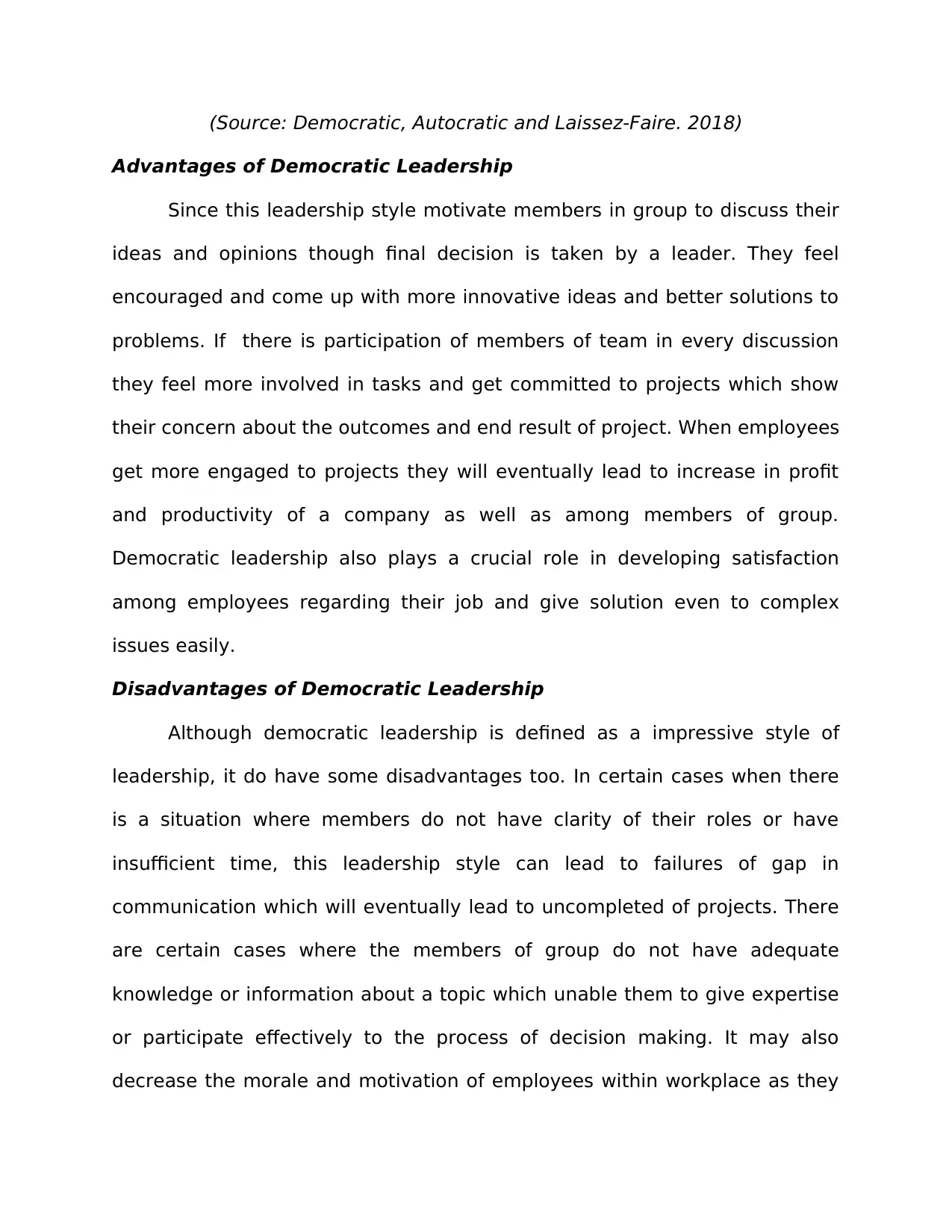
(Source: Democratic, Autocratic and Laissez-Faire. 2018)
Advantages of Democratic Leadership
Since this leadership style motivate members in group to discuss their
ideas and opinions though final decision is taken by a leader. They feel
encouraged and come up with more innovative ideas and better solutions to
problems. If there is participation of members of team in every discussion
they feel more involved in tasks and get committed to projects which show
their concern about the outcomes and end result of project. When employees
get more engaged to projects they will eventually lead to increase in profit
and productivity of a company as well as among members of group.
Democratic leadership also plays a crucial role in developing satisfaction
among employees regarding their job and give solution even to complex
issues easily.
Disadvantages of Democratic Leadership
Although democratic leadership is defined as a impressive style of
leadership, it do have some disadvantages too. In certain cases when there
is a situation where members do not have clarity of their roles or have
insufficient time, this leadership style can lead to failures of gap in
communication which will eventually lead to uncompleted of projects. There
are certain cases where the members of group do not have adequate
knowledge or information about a topic which unable them to give expertise
or participate effectively to the process of decision making. It may also
decrease the morale and motivation of employees within workplace as they
Advantages of Democratic Leadership
Since this leadership style motivate members in group to discuss their
ideas and opinions though final decision is taken by a leader. They feel
encouraged and come up with more innovative ideas and better solutions to
problems. If there is participation of members of team in every discussion
they feel more involved in tasks and get committed to projects which show
their concern about the outcomes and end result of project. When employees
get more engaged to projects they will eventually lead to increase in profit
and productivity of a company as well as among members of group.
Democratic leadership also plays a crucial role in developing satisfaction
among employees regarding their job and give solution even to complex
issues easily.
Disadvantages of Democratic Leadership
Although democratic leadership is defined as a impressive style of
leadership, it do have some disadvantages too. In certain cases when there
is a situation where members do not have clarity of their roles or have
insufficient time, this leadership style can lead to failures of gap in
communication which will eventually lead to uncompleted of projects. There
are certain cases where the members of group do not have adequate
knowledge or information about a topic which unable them to give expertise
or participate effectively to the process of decision making. It may also
decrease the morale and motivation of employees within workplace as they
Paraphrase This Document
Need a fresh take? Get an instant paraphrase of this document with our AI Paraphraser
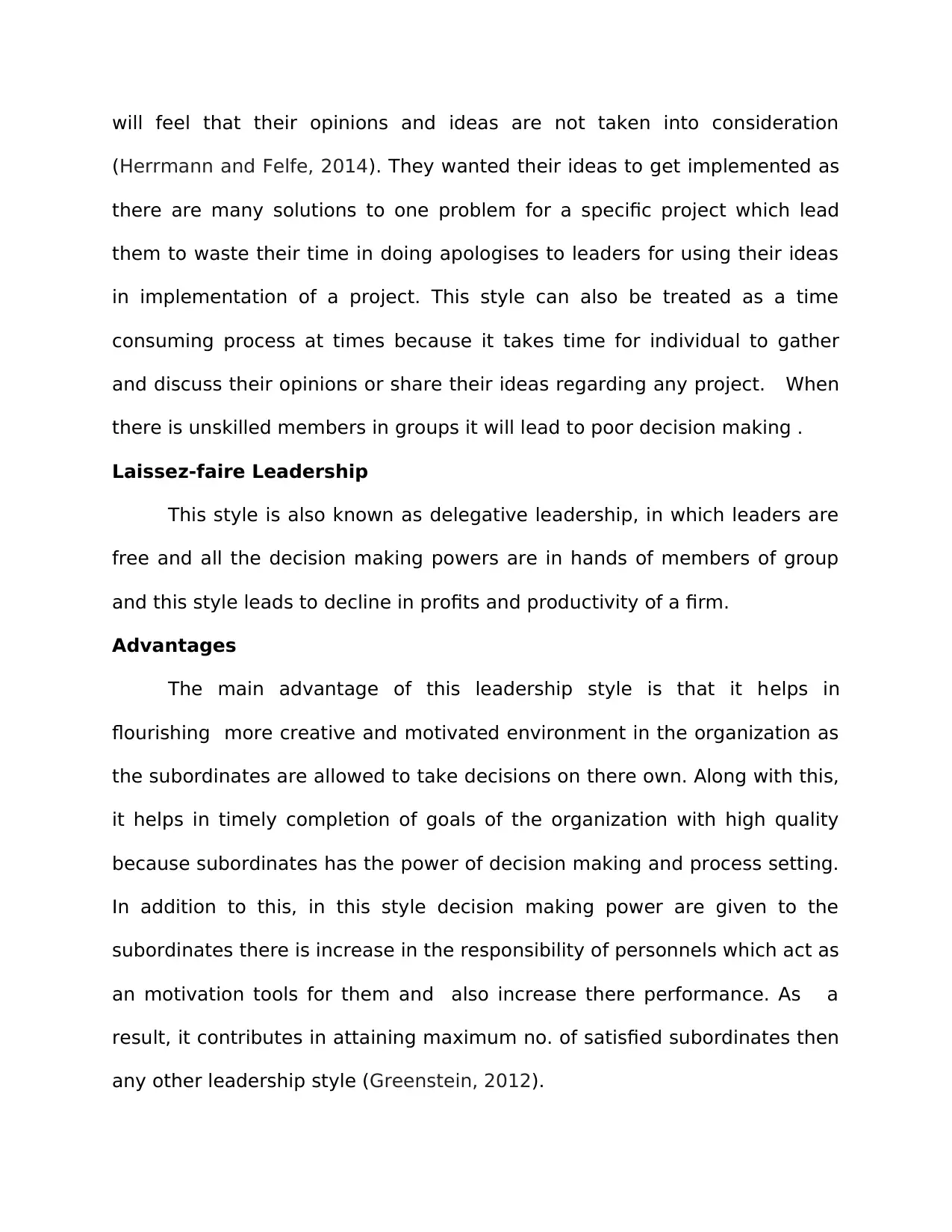
will feel that their opinions and ideas are not taken into consideration
(Herrmann and Felfe, 2014). They wanted their ideas to get implemented as
there are many solutions to one problem for a specific project which lead
them to waste their time in doing apologises to leaders for using their ideas
in implementation of a project. This style can also be treated as a time
consuming process at times because it takes time for individual to gather
and discuss their opinions or share their ideas regarding any project. When
there is unskilled members in groups it will lead to poor decision making .
Laissez-faire Leadership
This style is also known as delegative leadership, in which leaders are
free and all the decision making powers are in hands of members of group
and this style leads to decline in profits and productivity of a firm.
Advantages
The main advantage of this leadership style is that it helps in
flourishing more creative and motivated environment in the organization as
the subordinates are allowed to take decisions on there own. Along with this,
it helps in timely completion of goals of the organization with high quality
because subordinates has the power of decision making and process setting.
In addition to this, in this style decision making power are given to the
subordinates there is increase in the responsibility of personnels which act as
an motivation tools for them and also increase there performance. As a
result, it contributes in attaining maximum no. of satisfied subordinates then
any other leadership style (Greenstein, 2012).
(Herrmann and Felfe, 2014). They wanted their ideas to get implemented as
there are many solutions to one problem for a specific project which lead
them to waste their time in doing apologises to leaders for using their ideas
in implementation of a project. This style can also be treated as a time
consuming process at times because it takes time for individual to gather
and discuss their opinions or share their ideas regarding any project. When
there is unskilled members in groups it will lead to poor decision making .
Laissez-faire Leadership
This style is also known as delegative leadership, in which leaders are
free and all the decision making powers are in hands of members of group
and this style leads to decline in profits and productivity of a firm.
Advantages
The main advantage of this leadership style is that it helps in
flourishing more creative and motivated environment in the organization as
the subordinates are allowed to take decisions on there own. Along with this,
it helps in timely completion of goals of the organization with high quality
because subordinates has the power of decision making and process setting.
In addition to this, in this style decision making power are given to the
subordinates there is increase in the responsibility of personnels which act as
an motivation tools for them and also increase there performance. As a
result, it contributes in attaining maximum no. of satisfied subordinates then
any other leadership style (Greenstein, 2012).
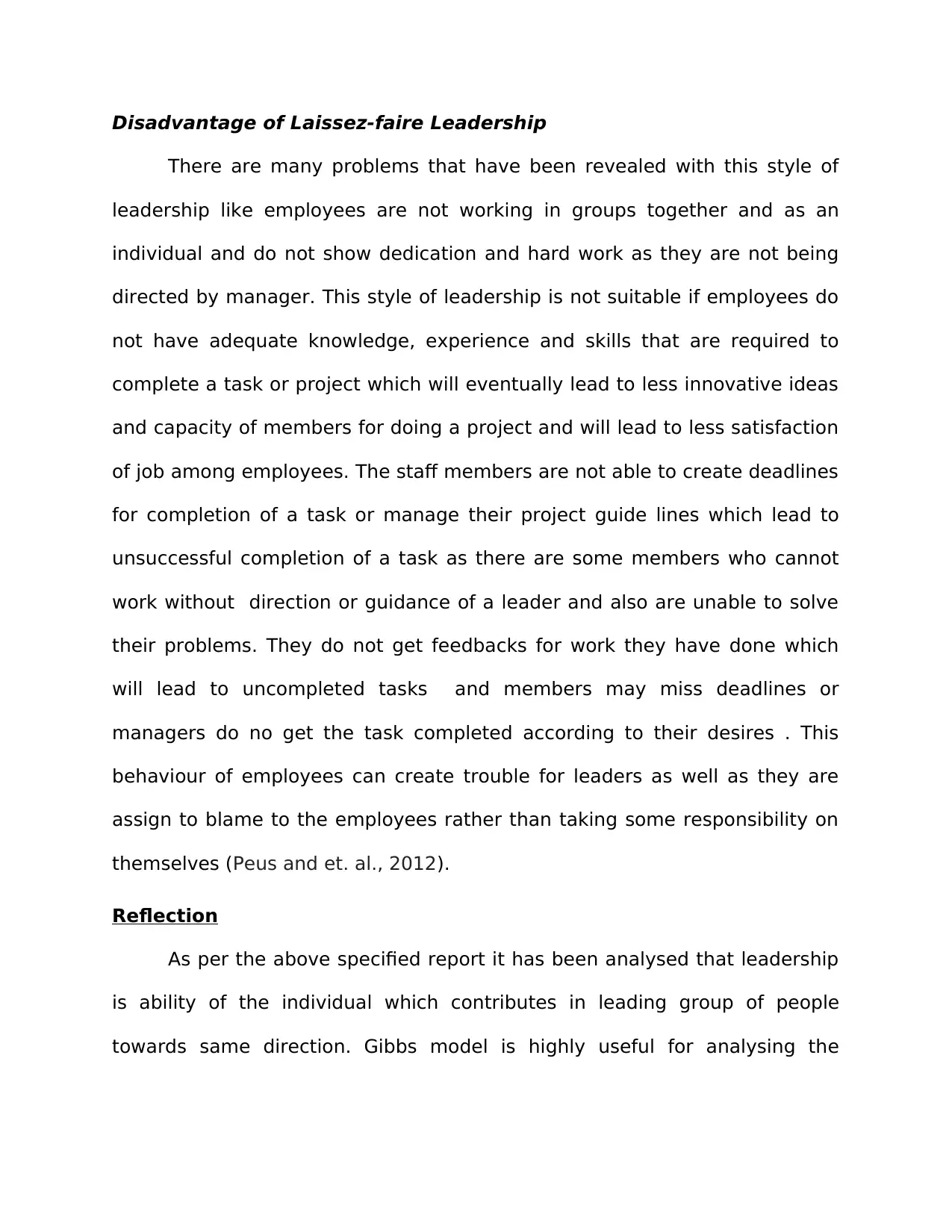
Disadvantage of Laissez-faire Leadership
There are many problems that have been revealed with this style of
leadership like employees are not working in groups together and as an
individual and do not show dedication and hard work as they are not being
directed by manager. This style of leadership is not suitable if employees do
not have adequate knowledge, experience and skills that are required to
complete a task or project which will eventually lead to less innovative ideas
and capacity of members for doing a project and will lead to less satisfaction
of job among employees. The staff members are not able to create deadlines
for completion of a task or manage their project guide lines which lead to
unsuccessful completion of a task as there are some members who cannot
work without direction or guidance of a leader and also are unable to solve
their problems. They do not get feedbacks for work they have done which
will lead to uncompleted tasks and members may miss deadlines or
managers do no get the task completed according to their desires . This
behaviour of employees can create trouble for leaders as well as they are
assign to blame to the employees rather than taking some responsibility on
themselves (Peus and et. al., 2012).
Reflection
As per the above specified report it has been analysed that leadership
is ability of the individual which contributes in leading group of people
towards same direction. Gibbs model is highly useful for analysing the
There are many problems that have been revealed with this style of
leadership like employees are not working in groups together and as an
individual and do not show dedication and hard work as they are not being
directed by manager. This style of leadership is not suitable if employees do
not have adequate knowledge, experience and skills that are required to
complete a task or project which will eventually lead to less innovative ideas
and capacity of members for doing a project and will lead to less satisfaction
of job among employees. The staff members are not able to create deadlines
for completion of a task or manage their project guide lines which lead to
unsuccessful completion of a task as there are some members who cannot
work without direction or guidance of a leader and also are unable to solve
their problems. They do not get feedbacks for work they have done which
will lead to uncompleted tasks and members may miss deadlines or
managers do no get the task completed according to their desires . This
behaviour of employees can create trouble for leaders as well as they are
assign to blame to the employees rather than taking some responsibility on
themselves (Peus and et. al., 2012).
Reflection
As per the above specified report it has been analysed that leadership
is ability of the individual which contributes in leading group of people
towards same direction. Gibbs model is highly useful for analysing the
⊘ This is a preview!⊘
Do you want full access?
Subscribe today to unlock all pages.

Trusted by 1+ million students worldwide
1 out of 19
Related Documents
Your All-in-One AI-Powered Toolkit for Academic Success.
+13062052269
info@desklib.com
Available 24*7 on WhatsApp / Email
![[object Object]](/_next/static/media/star-bottom.7253800d.svg)
Unlock your academic potential
Copyright © 2020–2025 A2Z Services. All Rights Reserved. Developed and managed by ZUCOL.





